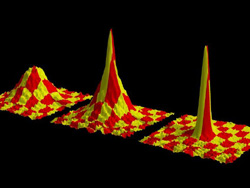Nobel Prize—The Coolest Atoms
This year’s physics Nobel Prize went to three researchers who were the first to observe and study the Bose-Einstein condensate (BEC), a new phase of matter. Wolfgang Ketterle of MIT, one of the Laureates, published his first BEC observation in the 27 November 1995 issue of PRL, just four months after the other two Nobelists published their work in Science. Ketterle’s experiment used a laser “plug” to trap the condensate and achieve much higher densities than the other team. Since then, dozens of BEC papers have appeared –each one further probing the nature of this strange form of matter.
In 1924, Satyendranath Bose and Albert Einstein published a series of papers on the statistics of certain non-classical particles. These theories later turned out to apply to particles with integer spins (bosons). Their work implied that if a collection of bosonic atoms could be cooled to the point that each one reaches its lowest possible quantum mechanical energy, a BEC would result. In this state, atoms would lose their individual properties and would act collectively as a single entity. A few years after Bose and Einstein’s work, physicists observed the first hints of BEC behavior. They observed a strange new phase of liquid helium which had no measurable viscosity. Called superfluid helium, the liquid was a few percent BEC, but creating a pure BEC was still decades away. It required technology for creating extremely low temperatures and a material that would not liquify before reaching the BEC phase./
In 1995, a group led by Eric Cornell and Carl Weiman at the National Institute of Standards and Technology in Boulder produced the world’s first true BEC. The group cooled a gas of rubidium atoms to a few hundred nanokelvin using magnetic and laser traps. The magnetic trap was particularly troublesome because its fields had a hole through which the atoms could escape, so Cornell and his colleagues had to use a second set of rotating magnetic fields to keep the atoms in place. Later that same year, Ketterle and his group produced a BEC with much higher densities. The team achieved these densities by “plugging” the magnetic field hole with a laser. The laser’s photons exerted a force on escaping atoms, pushing them back into the center of the trap. Using this technique, Ketterle and his team were able to create a BEC with ten times as many atoms at 100 times higher density.
Both Cornell and Ketterele’s groups observed a state of matter unlike any other. The condensates had densities of about a hundred billion atoms per cubic millimeter, and although the BEC could be milimeters across, it behaved something like a giant atom. In the years since, others have observed the numerous strange properties of BECs. When two condensates come together, for example, atoms suddenly vanish at the troughs of an interference pattern. And when researchers stir the condensate, they can never get a single vortex–dozens of smaller ones form instead. These improved experiments have helped BECs win a place in modern physics and in Nobel Prize history.
–Geoff Brumfiel



